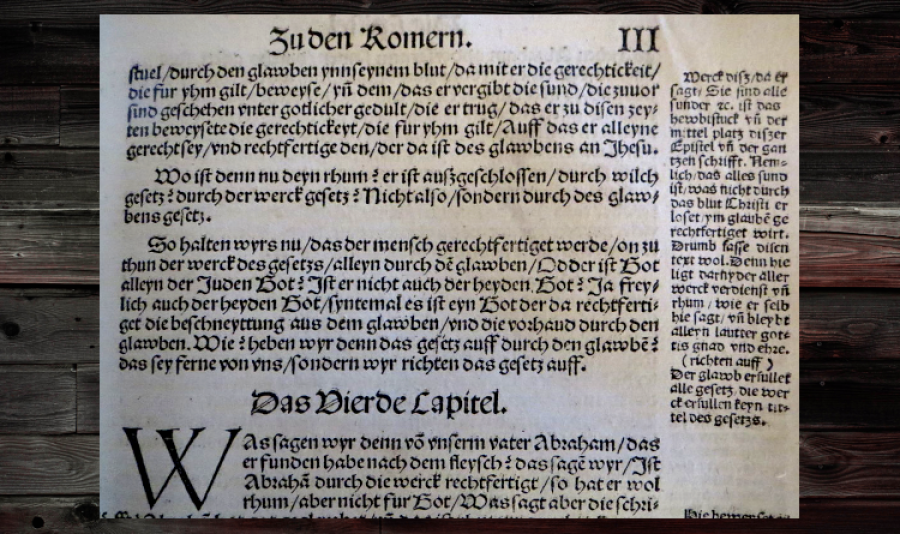The Reformation at 500: The September Testament
Image

Portion of Romans 3 from the 1522 September Testament.
As we continue to follow the events of the Reformation, 500 years later, we would be remiss if we failed to recall that half of a millennium has now passed since the dawn of the modern era of Bible translation. It began officially this month in 1522 with the release of the September Testament—the New Testament translated by Dr. Martin Luther into a language that he helped to form in Germany.
A placard at the Lutherhaus in Eisenach, Germany, captures the spirit of this endeavor: “Luther wanted the Bible to be understood. Everyone was supposed to be able to read God’s word on their own.”1
The publication launched on Sept. 21, 1522,2 allowing Luther almost seven months to settle back into his responsibilities as pastor and professor in Wittenberg, following his return from exile in the Wartburg Castle. I described the background, process and impact of this translation work in the castle in previous articles.3 However, I feel compelled to observe the anniversary of its publication, especially as we approach another Reformation Day, and our hearts are drawn once again to the significance of Sola Scriptura.
In the outside world, Luther’s life hung in the balance. But hidden safely within his mighty fortress high above Eisenach, he undertook a task so enormous that the results continue to reverberate down to our time.
The room in the castle where Luther completed the amazing 11-week project is nondescript—stark and barren—and it’s changed very little since 1522. One can almost feel the cold of the Thuringian winter through the small window, as it would reflect off of the plain wood-paneled walls and deteriorating plaster. Trapped in this environment day after day, one might surely sense the presence of the devil himself.
But what Luther accomplished during his stay in these quarters was nothing less than the transformation of Western civilization. Remember, also, the numerous factors that make his achievement even more astonishing. This was not his only writing project during this time. He was detained in the castle because of the threats against his own life. Yet he also bore a “deep concern for” (2 Cor. 11:28)4 the congregation back in Wittenberg. And he was suffering both physically and emotionally throughout this time.
Erwin Lutzer expands on this point, as follows:
Yet despite this incredible despair of soul, Luther discovered that his only cure for depression was work. During these ten months he wrote about a dozen books. But more important, a copy of Erasmus’s edition of the Greek New Testament was brought to him. From this edition he made a fresh translation of the New Testament into German in just eleven weeks!5
As I write this column, October beckons to us. Black and orange are once again becoming ubiquitous, along with all manner of décor fitting for All Hallows’ Eve. This is the season for spooks, demons, witches and death. This is the time each year that our culture chooses to reaffirm its celebration of horror.
Yet there is no reason to be afraid. Christ alone has overcome the “bondage” to the “fear of death” (Heb. 2:15) which chills each one of us. Furthermore, in a small, damp, cold room in the Wartburg Castle, a well of ink once drenched our enemy, the evil “prince” (Eph. 2:2)—marking him for eternal confinement.
And though this world, with devils filled,
should threaten to undo us,
we will not fear, for God has willed
his truth to triumph through us.
The prince of darkness grim,
we tremble not for him;
his rage we can endure,
for lo! his doom is sure;
one little word shall fell him.6
For five centuries now, people have been able to access Holy Scripture in a format that they can hold in their hands—and read in their own language. May the excitement of that wonder never grow old.
Photo by Concord, Wikimedia Commons, under CC 3.0 license (processed, resized, background added).
Notes
1 “In Good German;” visited Sept. 24, 2017.
2 “German New Testament published;” Reformation 500, Concordia Seminary, St. Louis, MO; n.d.; https://reformation500.csl.edu/timeline/german-new-testament-published/; Internet; accessed 29 September 2022.
3 See “The Reformation at 500: Luther’s Stay at the Wartburg (Part 1);” Sharper Iron; 22 April 2022; https://sharperiron.org/article/reformation-at-500-luther-s-stay-at-wart… Internet; accessed 28 September 2022; and “The Reformation at 500: Luther’s Stay at the Wartburg (Part 2);” Sharper Iron; 29 April 2022; https://sharperiron.org/article/reformation-at-500-luther-s-stay-at-wart… Internet; accessed 28 September 2022.
4 Scripture taken from the New King James Version®. Copyright © 1982 by Thomas Nelson. Used by permission. All rights reserved.
5 Erwin W. Lutzer, Rescuing the Gospel (Grand Rapids: Baker Books, 2016), p. 88.
6 “A Mighty Fortress” (1529). Public domain.
Paul Scharf 2019 Bio
Paul J. Scharf (M.A., M.Div., Faith Baptist Theological Seminary) is a church ministries representative for The Friends of Israel Gospel Ministry, serving in the midwest. He also assists Whitcomb Ministries and writes for “Answers” Magazine and Regular Baptist Press. For more information on his ministry, visit foi.org/scharf or email [email protected].
- 18 views


Discussion